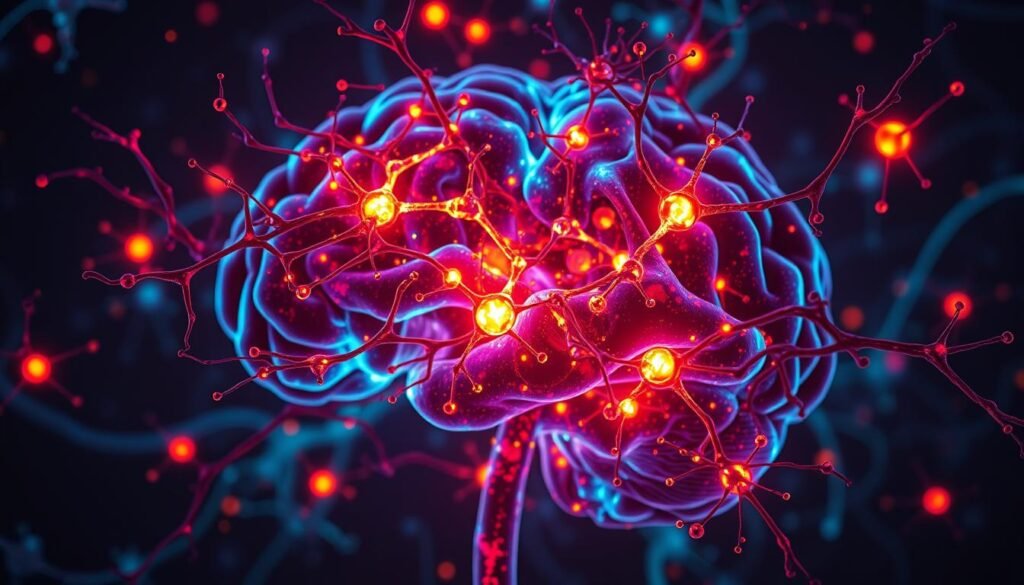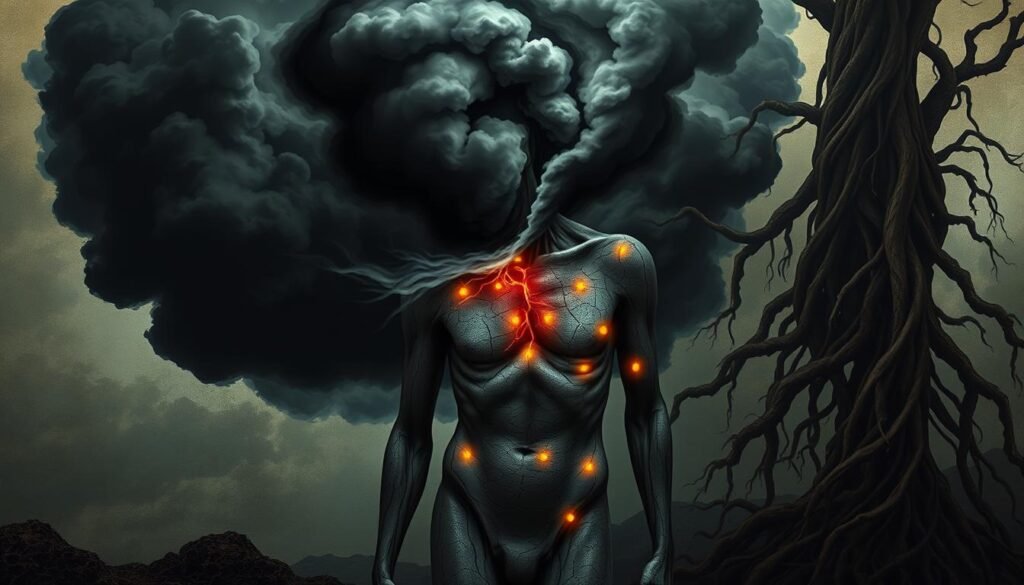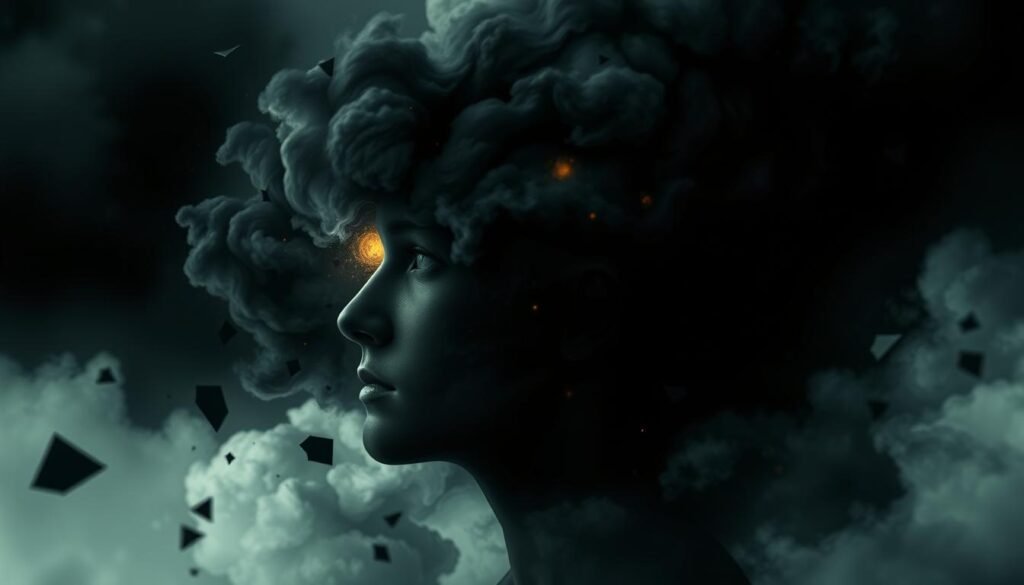About half of all people with Traumatic Brain Injury (TBI) feel depression in their first year. This fact shows how physical pain and mental health are closely linked. Post concussion depression makes recovery harder, mixing its symptoms with those of physical pain.
It makes diagnosing and treating these issues tough. Knowing how depression and physical pain connect is key. It helps in finding the right way to help those affected. This article will discuss the depression and physical pain link, focusing on TBI.
Key Takeaways
- Approximately 50% of people with TBI show signs of depression within the first year.
- The rate of depression in the general population is significantly lower than in those with TBI.
- More than half of those with TBI-related depression also experience significant anxiety.
- SSRIs like Sertraline (Zoloft®) are effective in treating depression in this population.
- The severity of a concussion can increase the risk of developing depression.
The Interrelationship Between Depression and Physical Pain
The link between physical pain and depression is complex. Many people with chronic pain fall into a tough cycle. Physical symptoms get worse and lead to deeper depression. The sadder they feel, the more pain they perceive. This makes it hard to get better. Treating both pain and depression together is very important.
Understanding the Vicious Cycle
Those with chronic pain often feel more depressed. This is concerning since many start with just physical problems. This can delay finding out they have a mood disorder. Up to 90% of traumatic brain injuries (TBIs) are mild but can have long-term effects on mental health. About 1.7 million people in the U.S. get TBIs each year. Many of them might deal with ongoing pain and depression, making their conditions worse.
Common Physical Symptoms Associated with Depression
Depression and physical symptoms often go hand in hand. Common issues include:
- Back pain
- Headaches
- Gastrointestinal issues
- Fatigue
- Muscle pain
These symptoms can point to mood disorders and affect daily life. Over 80% of people with concussions also see emotional changes. Knowing how pain and depression are linked is key to treating them. Focusing on both physical and emotional symptoms is vital to break the cycle. For further details on related studies, visit this link.
The Biological Basis of Pain and Depression
Understanding how pain and depression are linked shows a complex play of neurotransmitters. These chemicals are crucial for mood regulation and how we feel pain. The connection between serotonin and norepinephrine is especially key, affecting our minds and bodies.
The Role of Neurotransmitters
Neurotransmitters like serotonin and norepinephrine help keep our brain’s mood and pain centers in check. If serotonin levels drop, depression might increase. Meanwhile, norepinephrine deals with stress and alertness. When these systems are out of balance, this can lead to ongoing pain and sadness.
Dysregulation: Pain and Mood
This imbalance can start a harmful cycle, where pain feeds into depression, and vice versa. Chronic pain sufferers may feel alone, spiraling into sadness. On the flip side, being depressed can cause physical issues such as headaches or muscle pain, making diagnosis tricky. Addressing both pain and mood together can greatly help patients.

Identifying Physical Symptoms in Depression
It can be tough to spot depression signs because of different physical symptoms. Often, chronic pain might be the first hint, pointing to a possible mood disorder. Knowing this helps in recognizing that several physical complaints might mean a higher chance of having mental health problems, including depression.
How Pain Can Be the First Sign of Depression
Chronic pain often comes before depression, appearing before any sad feelings. People with headaches, fatigue, and similar issues might not immediately think of depression. This situation makes it hard to correctly identify mood disorders. This shows how critical it is to get the right depression treatment, as physical signs can make things unclear.
Chronic Pain and Its Role in Mood Disorders
Chronic pain can make emotional issues worse, creating a cycle that affects both. Research found that people with long-term pain, especially if injured before, often feel more depressed. College athletes with head injuries have shown more depression signs, linking physical harm to mood problems. This highlights the need for treatments that help both the pain and the emotional issues.

Post Concussion Depression and Its Symptoms
After a concussion, people may face big psychological changes. This can lead to post concussion depression. It is shown by different concussion symptoms and affects mental health a lot. Knowing about these changes helps with recovery.
Understanding Post Concussion Syndrome
Post concussion syndrome (PCS) happens after a traumatic brain injury. Symptoms can stay for weeks or months. Studies show 56% of those with a brain injury feel depressed around ten weeks later.
Many high school students with concussions feel sad and hopeless. A shocking 36.4% report these feelings.
Symptoms and Their Impact on Mental Health
PCS can make people feel more anxious and depressed. These issues can really hold someone back. Spotting them early is key. Changes in how neurons fire can lead to these problems.
Having a concussion and depression makes symptoms worse. This shows how connected they are.
To handle this, personalized treatment plans are needed. They focus on the injured brain areas. Wearing helmets in sports can also help prevent concussions.
This can lower the chance of getting post concussion depression. Tracking health and trying different treatments is important. Some common drugs might not always work. For tips on managing post concussion depression, check out this useful resource.

| Symptoms | Impact on Mental Health |
|---|---|
| Sadness | Increased risk of depression |
| Hopelessness | Worsening anxiety levels |
| Cognitive difficulties | Impaired daily functioning |
| Sleep disturbances | Exacerbation of mood disorders |
| Fatigue | Reduced quality of life |
Treatment Options for Depression and Pain
Treating depression and pain together brings hope for a better life. There are many ways to tackle these issues all at once. Learning how depression treatments and pain rehab work can lead to a happier life.
Dual-Action Antidepressants as a Solution
Some antidepressants work on both the mind and body. They can ease the challenges of treating depression. Drugs like venlafaxine and duloxetine help with chronic pain and make you feel better. This is great for those dealing with depression and chronic pain.
Comprehensive Pain Rehabilitation Programs
Managing pain means looking after your mental health too. Full pain rehab includes many types of therapy for all-around support. These may include:
- Physical therapy to improve movement and lessen pain.
- Psychotherapy to work through emotional issues, including depression.
- Mindfulness to help relax and lower stress.
- Educational help to better manage your health condition.
These programs build your physical and mental strength, improving how well you do. Getting involved in pain rehab along with depression care makes for a more complete recovery.
Psychotherapy and Its Benefits
Psychotherapy helps with pain and depression. Talk therapy is one good way to improve mental health. It lets people express feelings, learn to cope, and feel better overall. This method can reduce physical symptoms by dealing with their mental causes.
Talk Therapy for Pain and Depression
Talk therapy, especially Cognitive Behavioral Therapy (CBT), helps a lot with pain and depression. Research shows that CBT can change thinking patterns. This change can decrease anxiety and depression. Most patients who try CBT see their brain function get better, showing CBT works well for mental health.
- Engages healthier thinking patterns
- Short-term treatment effectiveness
- Online accessibility
- Absence of medication requirements
- Development of coping skills
- Educational components enabling self-therapy
CBT uses cognitive restructuring, guided discovery, and journaling. These techniques help people deal with chronic pain and depression better.
Stress Reduction Techniques
Reducing stress is key for mental well-being. This can help a lot with managing pain and depression. Using mindfulness, relaxation exercises, and deep breathing can make people more resilient to stress. Adding these methods to daily life helps in dealing with chronic pain and emotional problems.
| Stress Reduction Technique | Description | Benefits |
|---|---|---|
| Mindfulness Meditation | Focused attention on the present moment | Reduces anxiety and enhances emotional regulation |
| Progressive Muscle Relaxation | Tightening and relaxing muscle groups | Decreases physical tension and promotes relaxation |
| Deep Breathing | Controlled breathing techniques | Lowers stress levels and supports anxiety management |
Using talk therapy and stress reduction techniques together helps people feel better mentally and physically. These approaches lead to better overall well-being. It makes a big difference in people’s lives.
Cognitive Impairment and Mood Disorders
Cognitive impairment significantly impacts the development and progress of mood disorders, like depression. People with cognitive dysfunction after a brain injury may see their mental health worsen with their cognitive skills. The link between cognitive challenges and mood disorders is complex. As cognitive problems grow, mood disorders can get worse. It’s crucial to address both for successful recovery.
The Connection Between Cognitive Function and Depression
Studies show cognitive impairment often comes with difficulties in processing speed, memory, and executive function. These challenges can cause serious mood changes. After a brain injury, symptoms of anxiety and depression are common. This can lead to ongoing post-concussion syndrome. In these situations, treatment must help both the brain’s recovery and the person’s emotional well-being. About 13.5 percent of people with concussions report “poor cognitive outcomes,” increasing their risk of depression.
Impact of Cognitive Impairment on Brain Injury Recovery
Rehab after an injury is key to lessening the chance of mental health problems. Cognitive issues can slow recovery, affecting motivation and understanding of others. Nearly 10.1 percent of people score low on memory and speed tests, showing cognitive problems. Those with poor cognitive performance a year after injury often have conditions like diabetes, anxiety, and depression. Addressing these overlapping issues requires specific psychological and drug treatments. Creating environments that support cognitive activity can also help overcome the challenges of cognitive impairment and mood disorders.
For more information on how brain injury affects mental health, check out this resource. It discusses treatment options that cater to both cognitive and emotional needs.
| Cognitive Outcomes | Percentage of Patients | Associated Factors |
|---|---|---|
| Poor Cognitive Outcome | 13.5% | Concussions, mild TBI |
| Cognitive Impairment | 10.1% | Low memory and processing scores |
| Cognitive Decline | 3.4% | Drop in scores over time |
| No Cognitive Issues | 4.5% | Injury not due to concussion |
| Cognitive Impairment Without Concussion | 3.3% | None identified |
| Cognitive Decline Without Concussion | 1.2% | None identified |
Understanding the wider impact of cognitive impairment is key in creating effective treatments. Learn more about integrated treatment methods at this link. It covers approaches that focus on both cognitive and emotional health.
Strategies for Managing Co-Occurring Conditions
Managing conditions like depression and pain needs a whole-person approach. A holistic treatment plan should look at both mental and physical health. This means using meds, talk therapy, and changes in daily habits.
By treating both issues together, people can really improve their health. This approach offers a better chance at lasting relief.
Creating a Holistic Treatment Plan
Any good plan combines therapy, physical care, and support from others. Studies have found that teens with continuous concussion symptoms do better with this kind of care. They see a big drop in feeling sad.
In fact, 78% of these teens felt at least 50% less sad. This shows how important it is to care for mind and body together.
Importance of Addressing Both Physical and Emotional Symptoms
Ignoiring physical or mental symptoms can slow healing. People might feel tired, confused, and anxious because of pain and depression. It makes things harder.
Knowing how pain and depression are linked helps find the right treatment. Focusing equally on mental and physical health makes life better for those struggling.